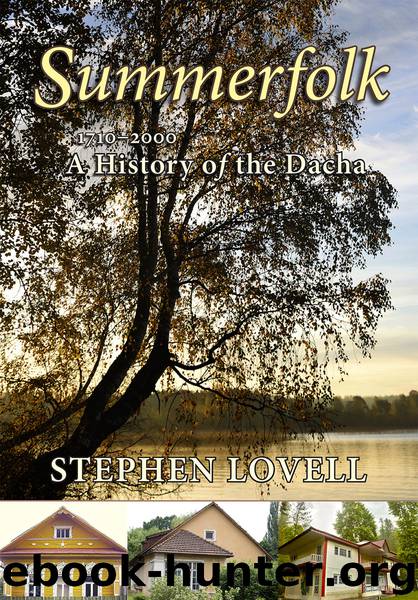Summerfolk by STEPHEN LOVELL

Author:STEPHEN LOVELL
Language: eng
Format: epub
Publisher: Cornell University Press
Published: 2016-08-09T16:00:00+00:00
A house at Sokol
The houses at Sokol were not dachas but were designed for permanent residence. In the mid-1920s, however, the idea of dacha cooperatives received fresh encouragement, the idea being that they would generate the resources to restore dilapidated dacha stock and to build new settlements.42 Cooperative building projects were further supported by the publication of standard designs for prefabricated dachas that could be assembled in a day without knocking in a single nail and with the help of just a few casual workers.43
Dacha cooperatives established in the second half of the 1920s were suitably modest in their objectives. Most houses built under their auspices were small and made of plywood. Even so, the practical difficulties proved to be immense. Cooperatives required considerable startup capital at a time when bank loans and other kinds of institutional funding were not easy to come by, and individual members did not generally have the personal means to make up the shortfall.44 At the start of the next decade construction projects became more ambitious. In 1932, cooperatives were entrusted with building 1,300 new dachas in the Moscow region (each to a standard design with two apartments, each of three rooms). But here too the press reported severe practical difficulties in obtaining the necessary credits and in coordinating the activities of the cooperative’s various branches.45In due course, attempts would be made to resolve these problems by tying the activities of a cooperative ever more closely to its sponsor organization; as we shall see, the “departmental” principle in dacha management triumphed comprehensively in 1937, when the cooperative movement was dealt a severe blow. Despite the negative press coverage, however, it seems that cooperatives functioned as efficiently as could reasonably have been expected, given the bottlenecked state of the Soviet economy. They also had a deserved reputation for apportioning space more liberally than did municipal settlements. In 1928–29 a dacha cooperative in the Leningrad area, for example, built new settlements at Toksovo and Tarkhovka. By later Soviet standards, these dachas stood on extremely spacious plots. The Toksovo settlement had forty-two plots that averaged 250 square meters, and the proportion of area given up to roads was unusually high; typically, only three or four plots stood in a row.46
But most Muscovites and Leningraders looking for a dacha in the 1920s did not have access to the municipalized stock and were not able to join a cooperative. Instead, they rented rooms or a whole dacha from locals. In April 1926, a representative of the Moscow dacha trust publicly admitted that his organization could not realistically compete with the private dacha market.47 A guidebook to the environs of Moscow, published in 1928, estimates a total of around 300 settlements populated in summer by vacationing Muscovites (these included both dacha settlements proper and peasant villages where houses were rented to city dwellers).48 Dachas were differentiated according to location and amenities. Prices could range from a few dozen rubles for the summer to around 300.49The dacha’s social constituency was by and
Download
This site does not store any files on its server. We only index and link to content provided by other sites. Please contact the content providers to delete copyright contents if any and email us, we'll remove relevant links or contents immediately.
| Anthropology | Archaeology |
| Philosophy | Politics & Government |
| Social Sciences | Sociology |
| Women's Studies |
Nudge - Improving Decisions about Health, Wealth, and Happiness by Thaler Sunstein(7247)
iGen by Jean M. Twenge(5164)
The Fire Next Time by James Baldwin(5022)
Adulting by Kelly Williams Brown(4236)
The Hacking of the American Mind by Robert H. Lustig(4090)
The Sports Rules Book by Human Kinetics(4079)
The Ethical Slut by Janet W. Hardy(4041)
Captivate by Vanessa Van Edwards(3730)
Mummy Knew by Lisa James(3522)
In a Sunburned Country by Bill Bryson(3371)
The Worm at the Core by Sheldon Solomon(3327)
Ants Among Elephants by Sujatha Gidla(3282)
Suicide: A Study in Sociology by Emile Durkheim(2906)
The Slow Fix: Solve Problems, Work Smarter, and Live Better In a World Addicted to Speed by Carl Honore(2838)
The 48 laws of power by Robert Greene & Joost Elffers(2812)
Humans of New York by Brandon Stanton(2690)
Handbook of Forensic Sociology and Psychology by Stephen J. Morewitz & Mark L. Goldstein(2604)
The Happy Hooker by Xaviera Hollander(2586)
The Tipping Point by Malcolm Gladwell(2562)
